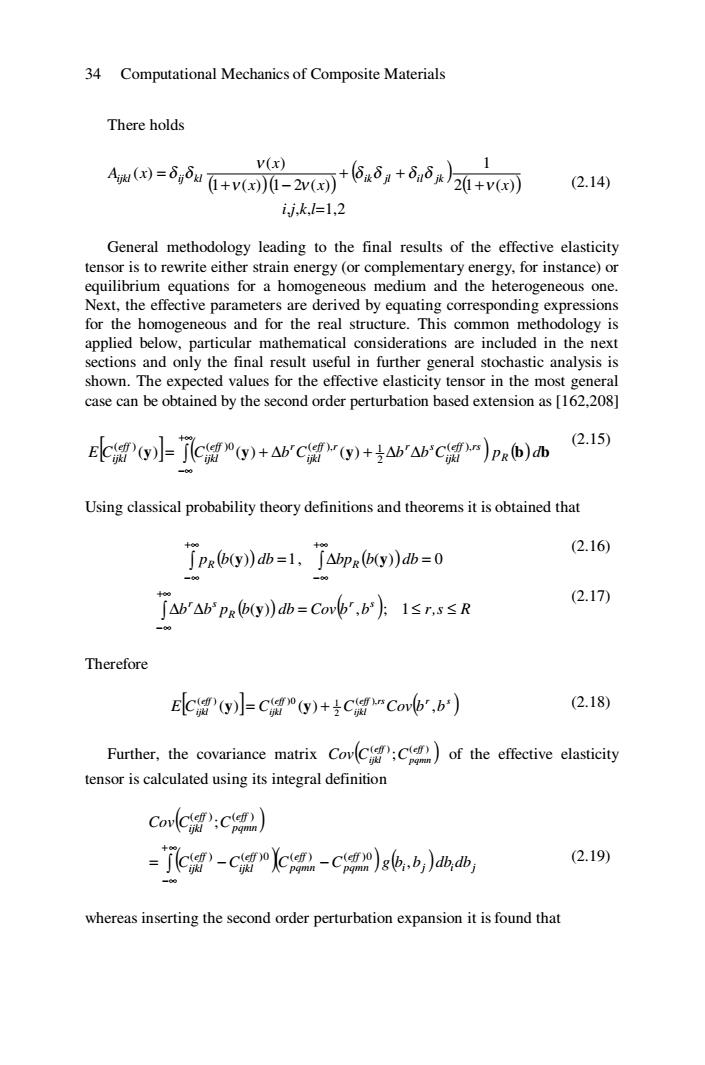正在加载图片...

34 Computational Mechanics of Composite Materials There holds 4国=66a+v是-2网*6.2+65:l20+同 v(x) (2.14) ij,k,l=1,2 General methodology leading to the final results of the effective elasticity tensor is to rewrite either strain energy (or complementary energy,for instance)or equilibrium equations for a homogeneous medium and the heterogeneous one. Next,the effective parameters are derived by equating corresponding expressions for the homogeneous and for the real structure.This common methodology is applied below,particular mathematical considerations are included in the next sections and only the final result useful in further general stochastic analysis is shown.The expected values for the effective elasticity tensor in the most general case can be obtained by the second order perturbation based extension as [162,208] ECg)小-门Cog)+AbCy)+5山△C")PRb)d (2.15) Using classical probability theory definitions and theorems it is obtained that jpx(6(y))db=1.jAbpx(b(y))db=0 (2.16 ∫△b'△bPRb(y)db=Comb',b)51≤r,s≤R (2.17) Therefore EC(y)]=C°y)+C“Cow6',b) (2.18) Further,the covariance matrix CovC C)of the effective elasticity tensor is calculated using its integral definition CovC':Cg) =jc-ccg-c)g6.b,), (2.19) whereas inserting the second order perturbation expansion it is found that34 Computational Mechanics of Composite Materials There holds ( )( ) ( )2( ) 1 ( ) 1 1 ( ) 1 2 ( ) ( ) ( ) x x x x A x ijkl ij kl ik jl il jk ν δ δ δ δ ν ν ν δ δ + + + + − = i,j,k,l=1,2 (2.14) General methodology leading to the final results of the effective elasticity tensor is to rewrite either strain energy (or complementary energy, for instance) or equilibrium equations for a homogeneous medium and the heterogeneous one. Next, the effective parameters are derived by equating corresponding expressions for the homogeneous and for the real structure. This common methodology is applied below, particular mathematical considerations are included in the next sections and only the final result useful in further general stochastic analysis is shown. The expected values for the effective elasticity tensor in the most general case can be obtained by the second order perturbation based extension as [162,208] E[ ] C y ( ) C y b C y b b C pR ( ) b db eff rs ijkl eff r r s ijkl eff r ijkl eff ijkl ∫ +∞ −∞ = + ∆ + ∆ ∆ ( ), 2 ( ) ( )0 ( ), 1 ( ) ( ) ( ) (2.15) Using classical probability theory definitions and theorems it is obtained that ( ) ∫ +∞ −∞ pR b(y) db =1, ( ) ∫ +∞ −∞ ∆bpR b(y) db = 0 (2.16) ( ) ( ) r s R r s ∫ ∆b ∆b p b( ) db = Cov b ,b +∞ −∞ y ; 1 ≤ r,s ≤ R (2.17) Therefore [ ] ( ) eff rs r s ijkl eff ijkl eff E Cijkl ( ) C ( ) C Cov b ,b ( ), 2 ( ) ( )0 1 y = y + (2.18) Further, the covariance matrix ( ) ( ) ( ) ; eff pqmn eff Cov Cijkl C of the effective elasticity tensor is calculated using its integral definition ( ) ( )( ) ( ) ∫ +∞ −∞ = − − i j i j eff pqmn eff pqmn eff ijkl eff ijkl eff pqmn eff ijkl C C C C g b b db db Cov C C , ; ( ) ( )0 ( ) ( )0 ( ) ( ) (2.19) whereas inserting the second order perturbation expansion it is found that